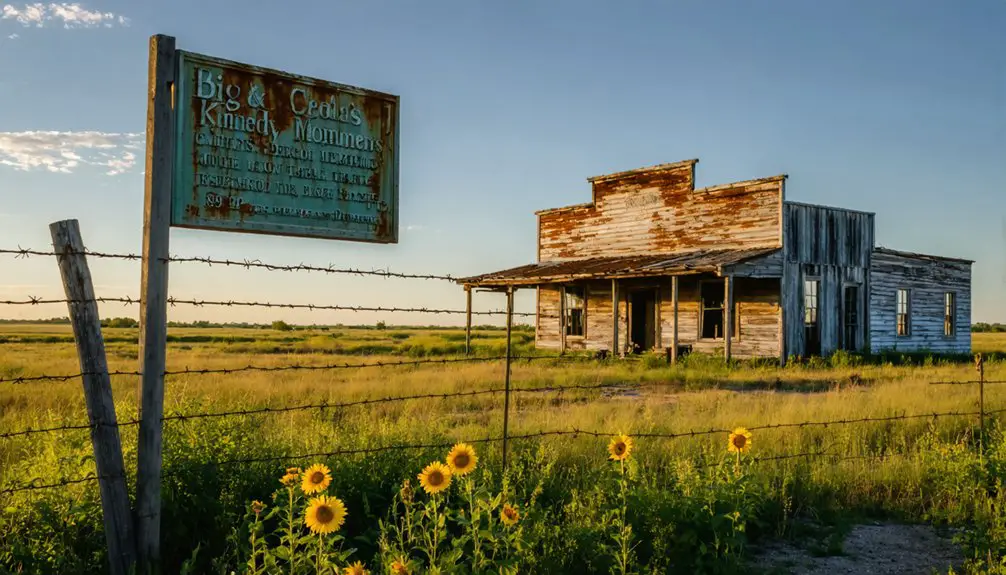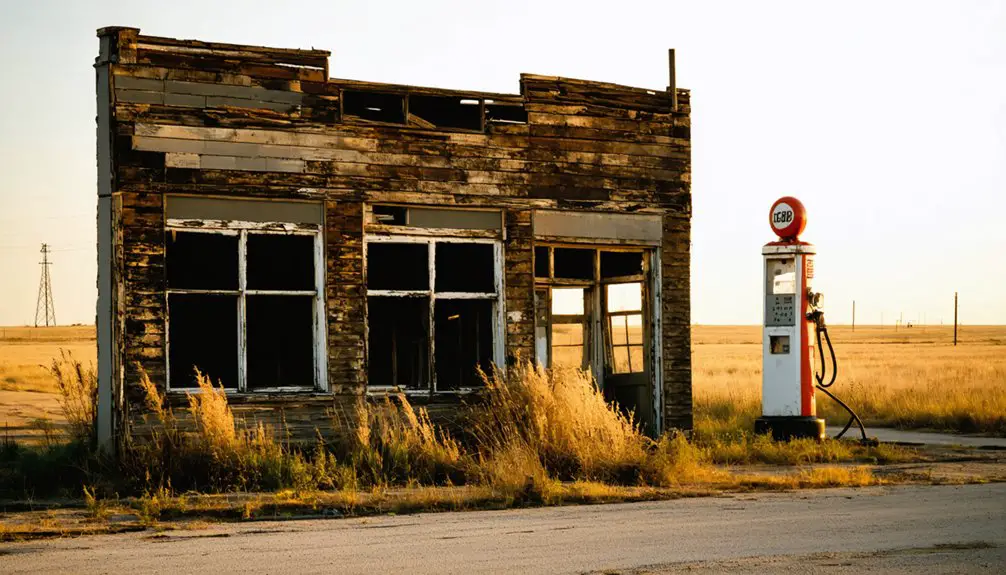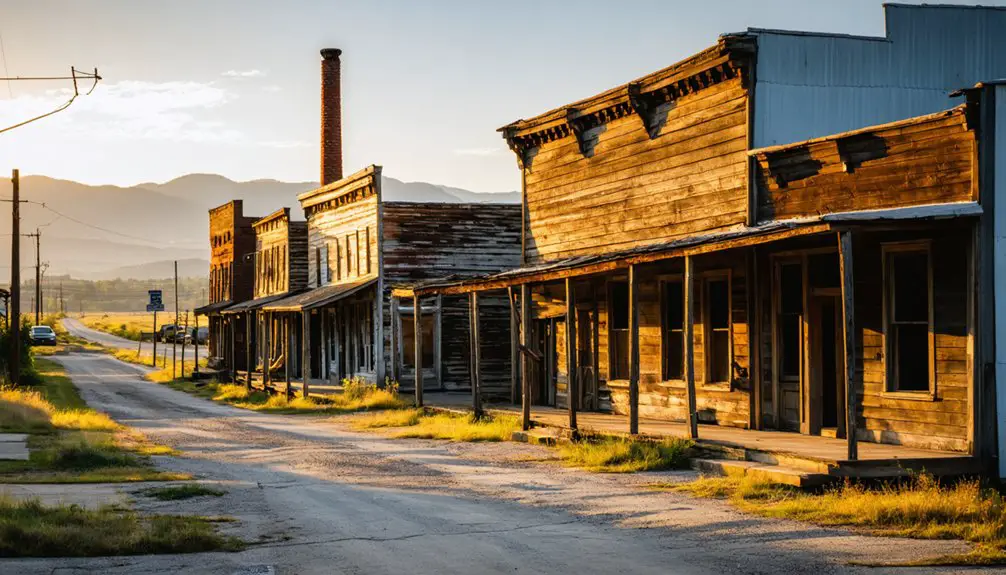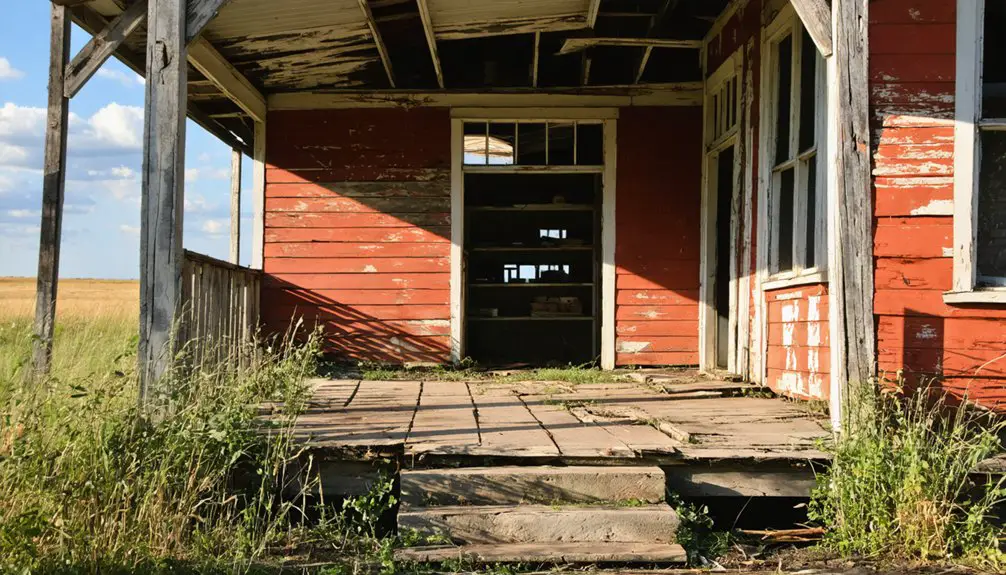You’ll find Big Cedar nestled in LeFlore County, Oklahoma, where it emerged as a thriving mill town in 1903 after establishing its first post office. The town reached its peak population of 695 residents in 1930, fueled by natural resource industries and its strategic location along military roads. By 2020, economic downturns and highway realignments had transformed Big Cedar into a ghost town with fewer than 200 residents. Its abandoned buildings and foundations tell a deeper story of boom-to-bust transformation in Oklahoma’s heartland.
Key Takeaways
- Big Cedar, Oklahoma, established in 1903, experienced significant decline after 1930, transforming from a thriving mill town into a ghost town.
- The town’s population dropped dramatically from 695 residents in 1930 to fewer than 200 by 2020, with a median age of 50.
- Highway realignments severely impacted Big Cedar’s gas stations and businesses, contributing to its eventual ghost town status.
- Original structures were primarily timber-built, though only foundations and partial ruins remain visible today.
- Located near Poteau, Big Cedar attracts history enthusiasts and photographers interested in exploring its abandoned buildings and historical remnants.
Origins and Early Settlement
While many Oklahoma towns emerged during the territorial expansion of the early 1900s, Big Cedar established its presence in 1903 with the opening of its post office. The settlement grew around the area’s natural features, particularly its namesake cedar trees, as pioneers sought opportunities in the newly opened territory. Similar to Kusa in its early days, Big Cedar dreamed of being a land of opportunity.
You’ll find that settler challenges shaped Big Cedar’s early development, as families built homesteads and tackled the demands of frontier life. The community growth centered on essential institutions, with residents establishing churches, schools, and basic commerce. Like many similar settlements that became ghost towns of Oklahoma, Big Cedar’s development was influenced by the availability of natural resources and economic opportunities.
These early settlers, primarily European-American migrants alongside some Native American influences, created a self-sufficient community focused on agriculture and local resource extraction. Without major railroad access, Big Cedar served as a modest trading hub for surrounding farms, reflecting the typical pattern of small Oklahoma settlements during the post-land run period.
Transportation Hub: The Gas Station Era
In Big Cedar’s early days, you’d find several independent service stations emerging along the Talimena Scenic Drive and former Butterfield Overland Mail Route to serve the increasing number of automobile travelers.
When major highway realignments occurred, the once-bustling fuel stops saw their customer base dwindle as traffic patterns shifted away from the small mountain community. Similar to how the Lugert grain elevator remained as one of the few landmarks after that town’s decline, Big Cedar’s old service station buildings stood as reminders of busier times.
Yet the legacy of Big Cedar’s gas station era lives on through remaining structures and memories of when this small Oklahoma town served as an essential refueling point for travelers exploring the southeastern region. Today, motorcycle enthusiasts still gather here to enjoy the beautiful fall colors while exploring the historic routes.
Early Service Station Origins
As automobile travel gained prominence in the early 20th century, Big Cedar’s strategic position near major routes in Le Flore County made it an ideal spot for service stations to emerge.
From the town’s founding in 1903 through 1943, these crucial early infrastructure hubs transformed local community interactions and supported the growing wave of motorists traversing Oklahoma’s highways. Similar to how the Jet Y Store established a commercial presence in 1904, these service stations became vital community fixtures. Like many towns that experienced economic shifts, Big Cedar’s service stations eventually succumbed to changing transportation patterns.
You’ll find these pioneering stations offered:
- Manual fuel pumps and basic vehicle repairs
- Essential supplies for road-weary travelers
- Oil changes and tire patching services
- Retail spaces for automotive accessories and maps
The stations weren’t just fuel stops – they became social centers where locals and travelers alike could gather, reflecting Big Cedar’s adaptation from a wagon-based economy to one centered on automotive traffic.
These family-run businesses established the foundation for Big Cedar’s brief but significant role in early automotive history.
Route Changes Affect Business
Following the realignment of major highways in Oklahoma, Big Cedar’s once-thriving gas station economy faced devastating setbacks that would ultimately contribute to its decline.
Like many Oklahoma towns before it that declined due to railroad route changes, Big Cedar became isolated from major transportation corridors.
As new transportation networks redirected travelers away from the town, you’d see fewer vehicles stopping for fuel, repairs, or rest breaks.
The route impacts were swift and severe. When the Interstate system made it easier for drivers to bypass smaller towns, Big Cedar’s strategic location lost its advantage. Like many of Oklahoma’s estimated two thousand ghost towns, Big Cedar fell victim to changing transportation patterns.
The dramatic business decline affected not just gas stations, but also repair shops and diners that depended on passing motorists. This created a downward spiral – as services closed, even fewer travelers had reason to stop.
The town’s role as a transportation hub eroded, leading to population loss and economic stagnation that transformed Big Cedar into another Oklahoma ghost town.
Fuel Stop Legacy Remains
During the early-to-mid 20th century, Big Cedar’s strategic location made it an essential transportation hub centered around its numerous gas stations. The fuel station evolution transformed this remote Oklahoma town into a crucial waypoint, where combination stations like Phillips 66 Type N offered both retail and bulk storage capabilities.
You’ll find these stations’ community impact reflected in their multifaceted roles:
- Served as social gathering spots while providing critical refueling services
- Created local employment through automotive repairs and merchandise sales
- Supported regional commerce by linking producers with transportation routes
- Anchored additional businesses like beauty shops and convenience stores
While few original structures remain today, these fuel stops helped shape Big Cedar’s identity and fostered economic growth during Oklahoma’s automotive expansion era. Situated near the Kiamichi River basin, Big Cedar became a vital rest stop for travelers navigating the challenging terrain of the Ouachita Mountains.
Their legacy lives on through historical preservation efforts and cultural documentation.
Daily Life in Early Big Cedar
While the sawmills hummed with activity, daily life in early Big Cedar centered around the timber industry and its supporting businesses. You’d find multigenerational families working side by side, passing down logging and milling skills through the ranks.
Generations of families shaped Big Cedar’s timber legacy, sharing their craft and building a community around the bustling sawmills.
When you weren’t at work, you’d gather at the general stores, churches, or post office to catch up with neighbors and trade local news. Community gatherings provided essential social connections in this hardworking town. Like many Oklahoma semi-abandoned sites, some residents remained in Big Cedar even as the population dwindled significantly from its peak years.
You might’ve joined your neighbors for outdoor activities, making the most of the surrounding wilderness. Your home would’ve been a modest wood-frame house, likely clustered near the mill for easy access to work.
Small-scale farming supplemented your family’s income, a common practice among residents who balanced timber work with subsistence agriculture.
The Kennedy Monument Legacy

You’ll find one of Oklahoma’s most meaningful presidential memorials in Big Cedar, where the Knights of Columbus erected a granite monument commemorating President John F. Kennedy’s 1961 visit to dedicate U.S. Highway 259.
The reddish-brown memorial, featuring Kennedy’s bronze profile and multiple inscriptions, stands as a tribute to the day when 25,000 people gathered to hear the President speak about Oklahoma’s progress since the Dust Bowl era.
The Knights of Columbus later transferred ownership of the monument and land to the Oklahoma Historical Society in 1966, ensuring its preservation as a lasting reminder of Kennedy’s connection to this small Oklahoma town.
Monument Origins and Purpose
In the aftermath of President John F. Kennedy’s tragic death, the Knights of Columbus established a monument that would forever mark his historic 1961 visit to Big Cedar, Oklahoma.
This reddish-brown granite memorial stands at the intersection of Highway 63 and U.S. 259, where Kennedy once addressed 25,000 people during the highway’s dedication ceremony.
The monument’s historical context and significance are reflected through:
- A tall central granite pillar featuring Kennedy’s bronze medallion portrait
- The Knights of Columbus emblem and commemorative inscriptions
- A three-tiered “stair-step” design symbolizing national recognition
- Preserved grounds with evergreen bushes marking this presidential tribute
The Knights later deeded the monument and land to the Oklahoma Historical Society in 1966, ensuring its preservation as a symbol of Kennedy’s legacy in rural Oklahoma’s development.
Presidential Legacy Lives On
Standing as a tribute to President Kennedy’s enduring impact on rural Oklahoma, the monument at Big Cedar continues to draw visitors and historians decades after its 1966 installation.
You’ll find this multi-tiered reddish-brown granite memorial encased by a protective rock wall, with concrete walkways forming a symbolic cross that connects the entrances. The Knights of Columbus established this homage to presidential influence, later donating both monument and land to the Oklahoma Historical Society.
The site preserves the memory of Kennedy’s momentous 1961 visit, when 25,000 people gathered to hear his six-minute speech celebrating local heritage.
A towering American flag and stately tree enhance the monument’s solemnity, while evergreen bushes maintain its year-round dignity along U.S. Highway 259.
Architecture and Notable Structures
Original structures in Big Cedar primarily featured local timber construction, reflecting the abundant forest resources of Le Flore County. The architectural styles incorporated simple rectangular floor plans with timber-frame designs, while stone foundations provided crucial stability against moisture and weathering.
You’ll find these key structural elements throughout the town’s history:
- Log cabins and board-and-batten siding dominated residential buildings
- Commercial structures showcased frontier-style false-front facades
- Gas stations served as essential waypoints for travelers
- Agricultural mills highlighted the town’s economic activities
Today, most original buildings have succumbed to deterioration, leaving only foundations and partial ruins.
While wooden structures have largely weathered away, surviving stone and brick elements offer glimpses into Big Cedar’s original layout and community design, preserving fragments of its frontier heritage.
Economic Changes and Population Shifts

While Big Cedar initially thrived from natural resource industries, the town’s economic fate shifted dramatically during the early 20th century. The town reached its peak population of 695 residents in 1930, but economic downturns following the Great Depression triggered a devastating decline.
As mining and oil operations became unprofitable, jobs disappeared and younger residents left for opportunities in larger cities.
You’ll find that population migration hit Big Cedar particularly hard, with numbers plummeting by approximately 70% to fewer than 200 residents by 2020. The median age rose to 50 years as younger generations departed.
The remaining economy evolved to less labor-intensive agriculture, focusing on wheat farming and cattle ranching. Infrastructure investments dwindled, and transportation route changes further isolated the community, accelerating its transformation into a ghost town.
Preservation Efforts and Current Status
Despite its historical significance, Big Cedar ghost town currently lacks formal preservation recognition or protection at the state level.
Big Cedar ghost town stands unprotected, its historical legacy fading without official recognition from Oklahoma preservation authorities.
While Oklahoma’s State Historic Preservation Office maintains a statewide plan through 2034, you won’t find Big Cedar specifically mentioned in any major preservation initiatives or endangered site listings.
The town faces several preservation challenges without organized support:
- No detailed structural condition reports exist to assess deterioration
- Absence from endangered lists limits access to preservation funding
- Weather damage and vandalism threaten remaining structures
- Limited community awareness has resulted in minimal local preservation efforts
The potential for future preservation exists if local advocacy grows.
You could help by engaging with LeFlore County historical societies or nominating the site through Preservation Oklahoma’s annual public nomination process.
Historical Significance in LeFlore County

Located in western LeFlore County, Big Cedar emerged as a significant settlement within the former Choctaw Nation territory after the 1830 Treaty of Dancing Rabbit Creek.
You’ll find its origins deeply rooted in the region’s Choctaw heritage, with nearby Skullyville serving as a temporary tribal capital and hosting important government facilities.
The town’s strategic location along military roads connecting Fort Smith to Fort Gibson and Fort Towson helped establish its importance.
By 1903, Big Cedar had secured postal recognition and developed into a thriving mill town.
The community’s evolution from Choctaw lands to a bustling settlement, and ultimately to a ghost town, mirrors LeFlore County’s broader transformation.
Its decline by 1943 reflected the changing dynamics of transportation and industry that reshaped many similar communities across the region.
Visiting Big Cedar Today
As a remote ghost town within the Ouachita National Forest region, Big Cedar offers adventurous visitors a glimpse into Oklahoma’s past, though accessing the site requires careful planning.
For a safe exploration experience, you’ll need to prepare adequately:
- Bring detailed local maps or GPS devices, as signage is minimal and cell service can be unreliable.
- Wear sturdy hiking shoes to navigate the rugged terrain and overgrown vegetation.
- Pack emergency supplies and water, as there aren’t any facilities or services on-site.
- Be alert for wildlife and unstable structures while exploring the ruins.
You’ll find mostly foundations and deteriorating structures reclaimed by nature.
While the site lacks formal preservation efforts, nearby towns like Poteau provide amenities and complementary historical attractions for your visit.
Frequently Asked Questions
What Indigenous Tribes Originally Inhabited the Big Cedar Area?
You’ll find the Osage were primary inhabitants, establishing Ho-tsa-Tun-ka near Big Cedar before Cherokee history intersected the region. The Osage culture dominated this territory alongside Kiowa and Comanche peoples.
Are There Any Documented Paranormal Activities in Big Cedar’s Abandoned Buildings?
Among Oklahoma’s 2,000 ghost towns, you won’t find documented ghost sightings or haunted history specifically tied to Big Cedar’s abandoned buildings. The town’s paranormal record remains surprisingly empty despite its ghost town status.
What Was the Peak Population of Big Cedar During Its Heyday?
You’ll find limited ghost town demographics for Big Cedar’s peak population, but historical significance suggests between 100-300 residents during its heyday, based on patterns of similar southeastern Oklahoma communities.
Why Was the JFK Monument Specifically Placed in Big Cedar?
During JFK’s rare Oklahoma visits, he dedicated Highway 259 there on October 29, 1961. You’ll find the monument exactly where he stood, preserving his legacy of bringing progress to this isolated mountain community.
Were There Any Notable Crimes or Dramatic Events in Big Cedar?
You won’t find records of notable crimes or dramatic events in the town’s history – no unsolved mysteries or documented ghost sightings that stand out from typical small-town tales.
References
- https://en.wikipedia.org/wiki/List_of_ghost_towns_in_Oklahoma
- https://www.wikiwand.com/en/articles/List_of_ghost_towns_in_Oklahoma
- https://www.youtube.com/watch?v=DVt5t7EwYC4
- https://cedarbayoumarina.com/four-ghost-towns-under-lake-texoma/
- https://kids.kiddle.co/List_of_ghost_towns_in_Oklahoma
- https://okcfox.com/news/local/oklahomas-secret-past-ghost-towns-of-oklahoma
- https://www.youtube.com/watch?v=5d-wHDTIbb0
- https://echo.snu.edu/the-ghost-towns-of-oklahoma/
- https://www.okhistory.org/publications/enc/entry?entry=GH002
- https://www.okhistory.org/about/markers.php?pageno=3&name=%%&county=%%&topic=%%%&action=Search



